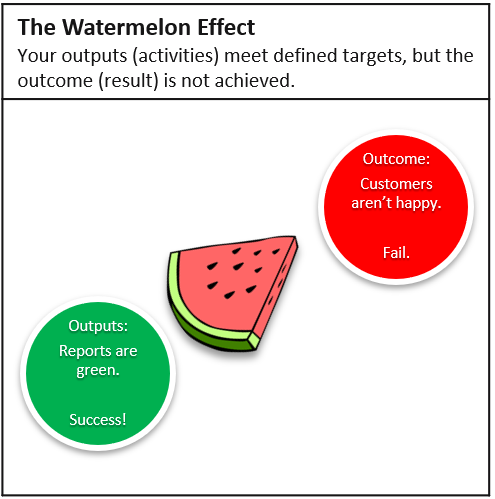
Today I want to share with you a chance discovery I made as part of a Service Review meeting. The service had been consistently achieving, rather overachieving all its SLAs and KPIs, but had just received an escalation from the customer. Tasked with the responsibility to unearth the reason behind the negative feedback, I soon deciphered that the service was a perfect example of the Watermelon Effect.
Sounds weird? Well, imagine a service that is green on all the KPIs but the moment you dig deeper you discover strong signs of ill-health. Just like a watermelon that is green and shiny on the outside and bright red on the inside.
Ironically, don’t all Service Managers aim for healthy green? Definitely so. Then why the escalation? Do SLAs mean nothing?
Not really, SLAs measure the output of a process or the extent to which it complies with a contractual objective. Contracts do demand that service providers meet all SLAs and KPIs and any failure gets flagged.
However, achieving or even overachieving your SLAs does not guarantee a positive experience for your end-users. In other words, your Service Desk agent might be closing all tickets within target, but does it leave the end-user with a pleasant experience? Maybe or maybe not.

To get a definite answer to this question, the industry is increasingly feeling the need to measure process outcomes rather than process outputs. The obvious question now arises – how do we measure process outcomes?
Yes, this is the point I have been eagerly waiting to share with you. Process outcome is best represented by value to the customer, or experience of the customer, to be precise, expressed in terms of Experience Level Agreements (XLAs).
Continuing with the Service Desk example, a green SLA means resolving the ticket within the stipulated time while a healthy XLA score signifies a happy customer. Isn’t that what all businesses are aiming for?
Exactly. But that does not mean you get rid of your SLAs and start focusing only on the XLAs. These two can work in tandem. You just need to identify metrics that speak about the process outcomes adding value to the customer and work towards meeting the targets.
Talking about targets, it is important to bear in mind that targets for XLAs need to be flexible because customer experience cannot remain static. Instead, it changes over time. And so should your targets, to align with your end-user expectations.
By now, if you are getting a faint idea about XLAs and how they work, you must realize that this change cannot happen overnight. Setting up XLAs is not purely an academic exercise. Instead, the organization needs to align to an end-user-centric culture that focuses not on punitive actions (as with SLAs), but on working collaboratively with the customer to make improvements for end-users.
If that sounds daunting, here are some important Do’s and Don’ts to work towards a successful adoption of XLAs by avoiding the possible pitfalls:
- When defining process outcomes, discuss and agree on the responsibilities of yourself as a service provider as well as your customer. Work in collaboration, not in isolation.
- Avoid using penalties for failed SLAs or even XLAs, as much as possible. Punishment drives numbers, not desired outcomes.
- Be open to adapt and change your XLA targets as your end-user experience evolves. Let your customers be your strongest brand ambassadors.
- Keep your people happy to inspire them to keep your customers happy.

In summary, it is now time to focus on adding value to the customer. They have always been the boss and shall remain so. Hence, identifying their pain areas and addressing them, gives you a bunch of happy customers, motivated teams and partners, and loyal shareholders. It’s a win-win situation all along. Therefore, take charge of your performance metrics, share accountability with your customers, and make them partners in your success…

